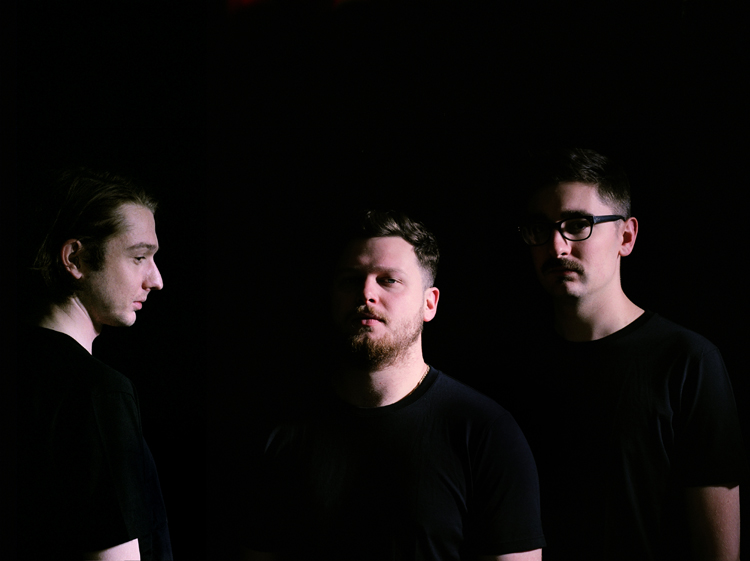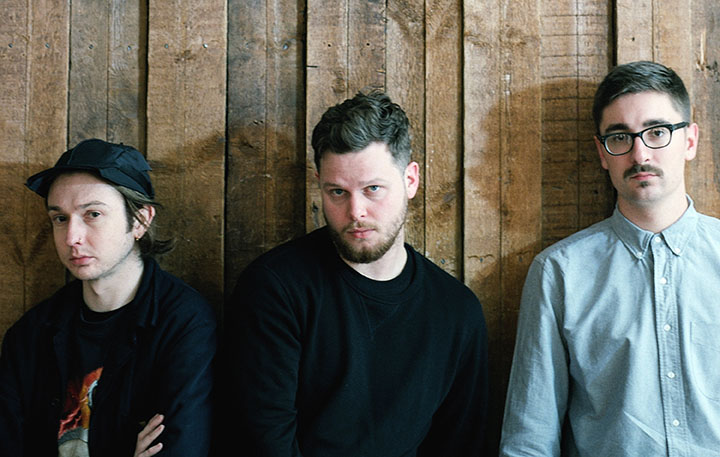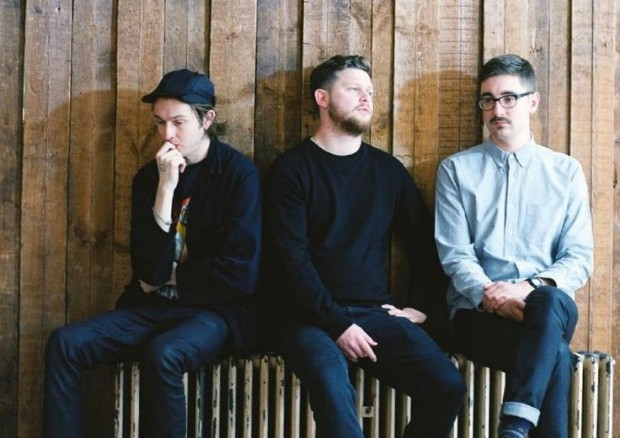Alt-J: Artful Dodgers

Swathed in warm, red light and billowy clouds of fog, the stage at New York’s venerable Beacon Theatre seems prepped more for a gothic bash with The Cure than a festival-like throwdown with the affable-looking guys in alt-J. Then again, lead singer/guitarist Joe Newman, keyboardist Gus Unger-Hamilton and drummer Thom Green are already known for their near-preternatural ability to dash expectations. How else could a group of literature and fine arts majors from Leeds University manage, virtually overnight, to knock British pop music on its proverbial backside?
It began with the band’s quirky and provocative 2012 debut An Awesome Wave, which merged pastoral psych textures with hip-hop-inflected “folk-step,” highlighting Newman’s shape-shifting vocals and surrealistic, cinematic lyrics (honed to perfection on the off-kilter single “Tessellate”), as well as the meticulously layered studio touch of producer Charlie Andrew. But whatever the descriptive label, from the early rock-crit favorites Nick Drake meets gangsta rap, In Rainbows-era Radiohead and John Martyn meets The Moody Blues, alt-J’s weirdly orchestrated music somehow hit a nerve, sparking a stratospheric rise that made the band one of the hottest new touring acts in the U.S. With sold-out shows in more than 20 cities last fall, and an unprecedented headlining date at Madison Square Garden planned as part of an extensive spring tour, alt-J are one of the few fledgling Brit outfits to break through in America on a scale that rivals Muse, Mumford & Sons and yes, even Radiohead.
Hype this massive can sometimes plow a young band under, and in alt-J’s case, the worst nearly happened. Shortly after An Awesome Wave won the U.K.’s coveted Mercury Prize, Newman grew wary of the microscope and eased back on talking to journalists. Then the band’s original bassist, Gwil Sainsbury, decided he was fed up with the rock-star lifestyle; the relentless touring, mind-numbing interviews and invasive distractions that come with instant celebrity simply proved to be too much. Frustrated and fatigued, he hit the bricks in January 2014, just as the band was gearing up to begin work on the successor to An Awesome Wave.
Where other bands might have caved, the remaining trio circled the wagons and forged ahead.
“I think we just thought, ‘Let’s see if this is all gonna be OK,’” Unger-Hamilton recalls. He and his mates decamped to a studio-warehouse space in East London to ease into writing new material. “We had some really good parties there, but we also got some really good work done, so it was perfect for us. I mean, there’s always gonna be a bit of pressure in the back of your mind after you make a successful album, but I think ultimately we just tucked ourselves away like we did with the first one. The approach was to forget we’re making an album and get on with it like we used to—just three guys who are really good friends and enjoy writing songs that result from that friendship.”
This Is All Yours, which was released this past September on Canvasback/ Infectious, comes across as a reflection on this solemn pact between friends, but there’s plenty more to it. Genre-hopping as usual, the band taps into some Floyd-ish mysticism from the get-go with the album’s “Intro”—a haunting ditty of layered vocal chants, churchy synths, plucky acoustic guitar and man-machine beats—before giving way to the misty, wintry mood of “Arrival In Nara.” That number chronicles a drowning (or a violent rebirth) with the jarring lyrics, “She never finds her bearing, sucking splash into her lungs/ Though I cannot see, I can hear her smile as she sings.” It’s pretty heady stuff for a group of guys whose social media-savvy, largely under-30 audience is understandably more concerned with having fun and making new connections than confronting emotional pain—but then, the album was meant to be as much for the fans as it is for the band.
“The title came from a painting I did at university,” Green reveals. “Basically it’s a black square with white writing that says, ‘This is all yours,’ with the idea that art is a gift that you have to offer. You make things from the ground up, and there’s nothing else like it—that expression, it’s a very human thing to do. So we’re saying to our fans that the music also belongs to them. We make it and we record it, and then it becomes their own experience. And I think that was true from the first album. After all the press and things, and meeting a lot of fans for the first time, it definitely feels like people have a personal connection to our music.”

Back in front of the lights at the Beacon, with newly recruited touring bassist Cameron Knight rounding out the foursome, alt-J opens with “Hunger of the Pine.” It’s This Is All Yours’ first single and another song charged with a yearning romanticism that might seem pretentious if it weren’t so heartfelt. The number also pivots on a well-chosen sample (“I’m a female rebel”) from Miley Cyrus’ hit “4×4.” As it turns out, Cyrus is also a fan, having selected alt-J’s marauding “Fitzpleasure” as a wardrobe-changing interlude on her recent world tour.
“Thom also did a remix for her,” Unger-Hamilton explains, “so he had all the vocal samples on his computer. We liked that ‘I’m a female rebel’ thing. He used it pretty heavily in his remix, so we put it in ‘Hunger of the Pine’ and it sounded really cool.” Cyrus gave the band her blessing to use the sample, at the same time handing them some extra clout in the American market— not that they really needed it. As the soldout Beacon crowd makes clear, alt-J is more than ready for prime time; the only question now is where they choose to go from here.
“I think we’ve grown up in the last four or five years,” Green reflects with conviction. In fact, he’s so thoughtful and introspective that he doesn’t quite fit the clichéd mold of the bludgeoning rock drummer—another quality that has undoubtedly shielded him and his mates from the perils of pop success. “It’s good because we have control of it now. I mean, we’re kind of sensible people anyway, but we know what we want individually. We make the most of our time off, and we’re not burning out or anything. We’re definitely in it for the long run. Longevity is something we really want.”
As hotly anticipated as it was in the months leading up to its release last fall, This Is All Yours isn’t a study in instant gratification. Instead, the album takes some time and patient listening to reveal its secrets—almost a throwback to the way that “concept albums” used to be made. “Maybe our music does take a lot of attention,” Green admits, “but it’s never a deliberate challenge that we set for people. So yeah, the tracks are meant to make for a full album. That’s why we had a hard time choosing singles. We were very adamant that ‘Hunger of the Pine’ was gonna be the first one. We didn’t want it to be anything else because we felt it really represented our new music well. It’s not too weird, like some of the tracks are, but it’s also new without being a throwaway thing like, ‘OK, here’s the single.’”
Recorded primarily in Charlie Andrew’s no-frills Iguana Studios in London, the album started to take shape during the writing sessions for “Nara,” a breakthrough epic that gave the band some much-needed confidence after Sainsbury’s departure. (“It’s tucked away behind a secondhand tire shop,” Unger-Hamilton quips of the band’s studio, “but it’s got everything we need, really!”) The song was eventually broken into three parts, providing some room for Newman to flex his truly offbeat narrative muscles in a subtext-laden ode that many fans have interpreted as a ringing endorsement of gay marriage. (“Unpin your butterflies, Russia,” he exhorts. “Hallelujah, Bovay, Alabama.”) And like the rest of This Is All Yours, the music is complex, impeccably mixed and stacked to the ceiling with aural textures. “Leaving Nara,” which closes out the album, moves through multi-tracked vocals, a deftly floating piano melody and a skeletal, electronic percussion sequence in the space of two minutes.
“I don’t think we were going for a particular sound,” Unger-Hamilton says when asked whether the band had a sonic palette in mind. “I think the richness of it is in the way that our maturity comes across in making our second album, you know? We wanted it to be something you could listen to many, many times before it properly sinks in. We didn’t want it to be a quick, sugar hit. We wanted it to be a deeply flavored meal, really. It’s important for us to make something that might last a long time, and not just be of the moment.”
Of course, the trio allowed themselves some frivolity. “Left Hand Free” is based on a dirt-simple blues guitar riff that Newman would sometimes play as a joke during soundchecks, but eventually it became a full-fledged garage-psych headbanger that the band couldn’t resist recording. When it was pushed hard to American rock radio and became a summertime hit, the British press—and some of alt-J’s own fans— flogged it as a sop to the band’s stateside record label. As is often the case in the overheated crucible of media scrutiny, that assessment turned out to be a wild exaggeration. “We never aim to make a certain type of music,” Green insists, “so if we’d rejected ‘Left Hand Free,’ I think it would have been cowardly of us. So we recorded it, and still we weren’t sure we wanted it on the album, but then we were like, ‘Yeah, fuck it. We like it.’ Then, the U.S. label heard it and wanted to release it as a single, and we were like, ‘Well, we don’t want to because it’s a joke. This isn’t the intelligent alt-J that we’re trying to portray.’ [Laughs.] And then we realized it is what it is, and that it would probably do well. Of course, we didn’t realize it would do as well as it has.”
True to its promise, This Is All Yours serves up a little something for everyone. It’s new, unusual and even inscrutable music that frustrates as much as it excites, from the over-the-top sexual theme of “Every Other Freckle” to the Alien-inspired “The Gospel of John Hurt.” (Think of the Ridley Scott film’s chest-bursting scene for the full picture. Newman sings the first half of the song through a vocoder, which adds to the sense of encroaching dread.) The album also features guest shots from alt-J’s ever-expanding circle of friends, including Conor Oberst, Lianne La Havas and newcomers Marika Hackman and Sivu, all of whom gather around the microphone on “Warm Foothills”—a meditative foray into pastoral, almost Appalachian-sounding folk that gradually surges with lush orchestral flourishes.
A key component of the band’s sound comes from their producer, but as Green is quick to point out, the finished album is a collaborative effort across the board.
“I think Charlie understands we’re just passionate about what we do,” he says. “He’s a drummer and he’s been in bands for a long time, so it’s good to have his ear. Honestly though, when you’re in the studio, you have to leave your ego completely aside. You can’t be precious about things; it has to be about the group. If two people in the band want to do something and you really don’t want to do it, you have to just trust their instincts. And it always works.”
With that in mind, alt-J won’t easily take on a cover song unless there’s a good chance that they can claim it as their own—that’s how they stumbled onto the Bill Withers soul classic “Lovely Day,” which made the album as a rare bonus track.

“Joe grew up with a lot of soul and funk music,” Unger-Hamilton says, “and one day, we had this really nice jam where I was just playing these flute sounds, Joe was playing guitar and Thom was playing some nice beats on the kit. And then, Joe just started singing ‘Lovely Day’ sort of absent-mindedly, and it really worked well. We don’t often do covers because it’s hard to find the right song, but sometimes the right song finds us. When we tried this one, it just came across naturally.”
The hard work that went into making their second album together gave each member of the band a real taste for songcraft, whether it comes down to cover choices or which chorus works with a particular verse.
“We wanted to make an album that was interesting for people to listen to,” Unger-Hamilton continues, “but it’s also more than that. With all our songs now, we want every ingredient to make itself heard. We don’t like to have an instrumental part in a song that’s just there to fill it out, you know? If you can’t justify why a certain part is in a song, you should take it out— create some space where you can because the more space you have, the more the individual components can breathe. That’s the best way for us to record songs, really.”
So forget the hackneyed talk of a sophomore slump. As self-aware as any band that’s been through the tabloid ringer and lived to tell about it, alt-J no longer have anything to prove, but plenty left to accomplish. Green talks excitedly about expanding more into production. He claims an addiction to the music of hip-hop upstart Clams Casino, and works just as obsessively on his own beats with Ableton Live looping software. At the same time, Unger-Hamilton continues to branch out on the electronic side—he contributed a sizable swath of programming chops to This Is All Yours—while Newman has managed to shape his voice into a real instrument, and seems to be gaining confidence with every show.
“It’s a very interesting time for us,” Green acknowledges. “We have a broad spectrum of tools to use to write our music—especially when we start looking to the third album. When we finish this tour, we’re gonna take some time off. I want to build a studio myself, and I want to do my painting again. I’m very excited about that. We can pretty much say now that we do what we like, and we don’t have any genre rules. So the third album might be completely different, with a 12-minute violin solo or something. That would be pretty cool.”



















